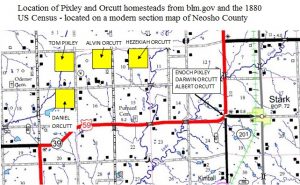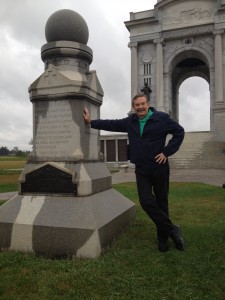In Part One I wrote about discovering Tom Pixley’s life prior to the Civil War and how, after the war, he sought his fortune in Montana’s gold fields.
After two fruitless years of prospecting the Prickly Pear Valley, Tom gave up his quest for riches and, tucking his tail between his legs, headed back towards his family home in upstate New York – but he didn’t make it. Tom wrote in his army pension request “I then went to Eaton County in Michigan”. I found a railroad map from that era posted online by the University of California Berkeley, showing the rail route Tom would have chosen – and it passed right through Eaton County. Obviously he got off the train for some reason, but I couldn’t imagine why in Eaton County.
I called the Eaton Historical Society to see what might have lured a young man like Tom, and they really couldn’t answer my question. One member of the society speculated Tom might have been drawn by Olivet College, but I didn’t think that likely. No family story ever accused Tom of being an academic; he was most often described as restless and for the last six years had been living an adventurous life, first as a cavalryman and then in the lawless gold fields of Montana. I just couldn’t see him giving up his exciting lifestyle to attend a college – especially one founded and taught by missionaries of the Congregational Church. I kept looking for another reason.
Sometimes you have to get lucky, and I got lucky. Thinking he might have stopped to visit a family member, I searched Findagrave.com for anyone named Pixley buried in Eaton County … and I found 24 dead Pixley’s. Ten of them would have been alive in 1869.
I had never before taken time to identify all of Tom’s uncles, aunts and cousins, so now I used Ancestry.com to do just that and found one of those ten dead Pixley’s who looked promising – Theodore Pixley. I discovered Tom’s father had a half-brother named Theodore, but what convinced me the two Theodore’s were one in the same is the Michigan Theodore named his daughter Ella – Tom also named his oldest daughter (my great grandmother) Ella. So I’m guessing the reason Tom got off the train in Eaton County had something to do with his Uncle Theodore, but what was Theodore Pixley doing that kept Tom in Michigan for much of 1869?
Using Genealogy.com I searched old newspapers from that year and discovered an article and a series of advertisements published in the Jackson Citizen Patriot, announcing the reopening of the Hastings House Hotel. The article told how the hotel had been purchased by Theodore Pixley who “refitted and refurbished the hotel and intended to keep it in a first-class manner”. I suspect that hotel had something to do with Tom staying in Michigan. I think when he got off the train Tom was pretty much dead broke and I know his uncle needed laborers to refurbish the hotel, so it’s my guess Uncle Theodore offered Tom a job and Tom took him up on his offer for several months.
Tom wrote in his pension request of how he then moved on to Neosho County, Kansas later that year. Since I have the marriage license, I know that was where, several years later, he married Mary Jane Orcutt, my great-great grandmother. But why did he go to Kansas in the first place?

Neosho County 1870-1880
Using the same trick as in Michigan, I searched Findagrave.com for any Pixley buried in Neosho County and found Enoch and Ann Pixley who died in 1907 and 1908. I looked to see if I could connect Enoch and Ann to Tom, and found them all in the 1875 Kansas State Census living very close to each other. So it appears Tom left the Pixley’s in Michigan to visit the Pixley’s in Kansas, and decided to stay. While looking for Enoch I also found lots of Orcutt’s (Mary Jane’s family) living all around. In fact, there were so many Orcutt’s in that corner of Neosho County the US Postal Service named the area Orcuttville in 1870 and appointed Mary Jane’s father, Daniel, postmaster of the Orcuttville post office. I found that information online in the Appointments for US Postmasters, 1832-1971.
Figuring free land might have been the reason Tom stayed in Kansas; I looked at the Bureau of Land Management’s website and found, indeed, Tom was granted a quarter section of land (160 acres). And it turned out his land was right next to Daniel Orcutt’s homestead, and so now I also knew how Tom met his future wife – he was their next door neighbor. Of course, when Tom first showed up he and my future great-great grandmother had to wait a few years for her to mature, you see when they finally married Tom was thirty years old and Mary Jane was only fifteen.
Even back then this was a little young for a girl to marry, and so she needed her father’s permission – but why shouldn’t he approve? He was 55 years old after all and still had four unmarried daughters living at home. It must have sounded like a pretty good deal to unload one of those girls and, in fact, he agreed … and that explains why his written permission for her to marry is printed on their marriage license.

 I don’t want to just find my ancestors; I want to discover their life stories and maybe unwind a few family mysteries along the way. Ancestry.com is great for identifying those long dead relatives, but sometimes the best information is not on line at all, sometimes you have to go looking for an original document in a courthouse or church. I love that kind of search, where my reward is finding a document that has been untouched for over a hundred years.
I don’t want to just find my ancestors; I want to discover their life stories and maybe unwind a few family mysteries along the way. Ancestry.com is great for identifying those long dead relatives, but sometimes the best information is not on line at all, sometimes you have to go looking for an original document in a courthouse or church. I love that kind of search, where my reward is finding a document that has been untouched for over a hundred years.
Recent Comments